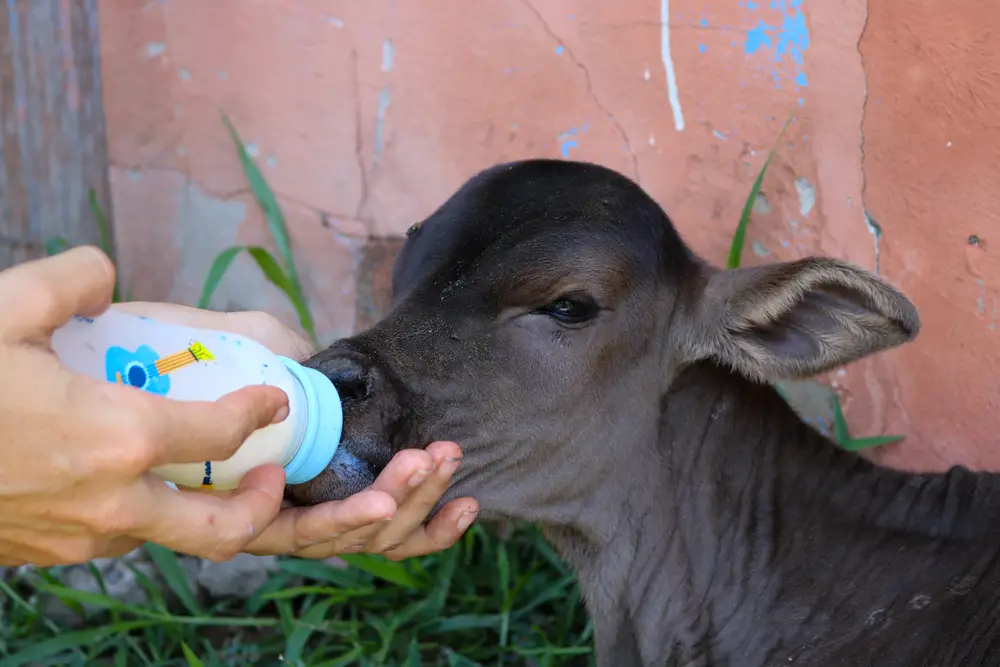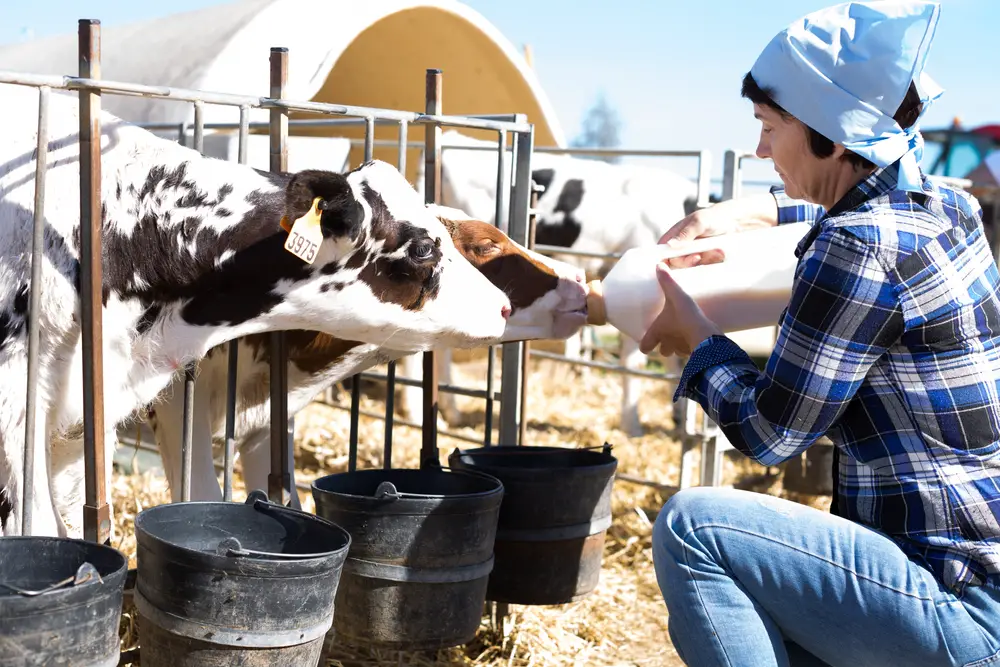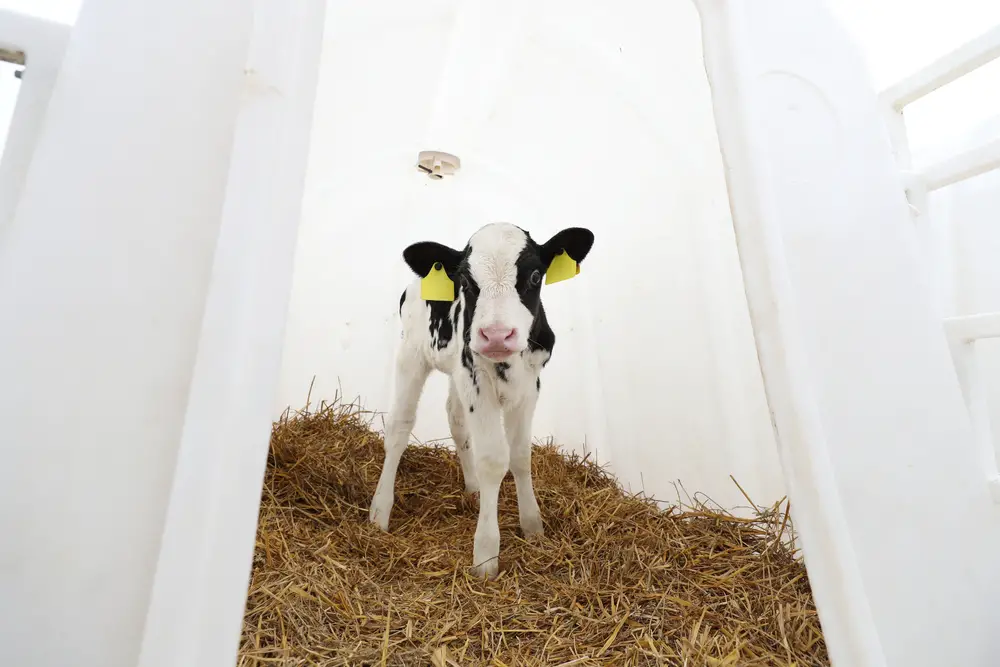You can raise a calf without the mother in two main ways—using the bucket feeding method or the bottle feeding method. You can also use the tube feeding method instead if the calf cannot feed using the first two methods.
Raising a calf without its mother can be tricky, but it doesn’t have to be, regardless of why the calf is not on the cow in the first place. There are several aspects to consider beyond just the feeding method, such as what feeds and supplies are required.
Table of Contents
What You Should Expect
It can be tricky being a newborn calf’s human mother when its bovine mother can’t raise it from birth to adulthood. Here’s what to expect, especially if it’s your first time:
- Head-butting: Healthy calves are highly excited and supercharged younglings that can be messy at times. Head-butting is common when raising calves because they think they are sucking on a teat from a real udder, particularly when you feed them by the bottle. Feed spillages are frequent, which can be wasteful of money and time.
- Scours: The temptation to overfeed calves is always there, leading to calf scours that can result in death in desperate situations. Scours in baby calves can also result from viral and bacterial infections, but the main culprits are overfeeding and irregular feeding. This calls for knowing exactly how much your calf needs and maintaining a regular feeding routine.
- Underdevelopment: If you underfeed your calf, it will be deprived of essential nutrients and the energy required to grow and increase body weight.
- Frequent calls to the vet: Even though every dairy farmer dreads seeing a sick calf, sometimes you’ll have to reach out to a veterinarian for treatment out of no fault of your own. Calves are vulnerable to pathogens since their immunity is still low.
Most importantly – expect to be patient and prepare yourself for the long haul (several months), especially if you’re raising multiple calves at the same time.

Feed and Supplies
Here’s the inedible hardware you’ll need:
- Feeding bucket/calf bottle with a few changes of nipples
- A calf feeding tube for when bucket or bottle feeding fails
- Thermometer for taking the temperature of liquid-based feeds before presenting them to the calf
- Mixer or mixing whisk for beating milk-based feeds into a smooth mixture.
- Spouted and calibrated milk containers for measuring exact quantities of liquid feeds.
- Small weighing machine for measuring precise amounts of granular or powder-like feeds.
Most of these tools you’ll likely already have if you’re actively milking your cows.

You can raise your bucket or bottle calves on feeds such as:
- True colostrum milked from the mother or another freshened cow. Feed this to the calf within an hour after birth to enhance the absorption of antibodies.
- Commercial colostrum, if you don’t have true colostrum.
- Full milk/whole milk from another cow or a goat. Whole milk is better than a milk replacer.
- Milk replacer. This should be whey-based and meant for specifically for cows.
- Freshwater. Provide clean water from the fourth day to reduce the incidence of scours
- Electrolyte solution if the calf has scours
- Calf starter feed from the fourth day up to 3-4 months of age when weaning happens. A grain-based calf starter is essential since proteins help prevent the potbelly or bloat-like look of most bottle or bucket calves.
- Roughage from high-quality hay of immature grass or leafy alfalfa. Growing grass is also okay. Provide this from 1 week of age to promote rumen development, which takes 4-6 months.
Grower and Finishing Diets
You can start feeding your calf on a calf grower when it’s about four months of age. The calf may be weaned at this time, or it could be another 1-2 weeks yet if it’s dairy beef, 3-5 more weeks if it’s beef cattle, 4 more for dairy calves, or 4-8 more if the calf is weak.
Feed calves on grain shared two or three times a day and free-choice hay until it’s 6 months old and can turn forage into protein. If you start the calf on a grower diet when it’s not yet weaned, offer it less milk than before until all milk is withdrawn.
Beef calves require more protein than energy to grow, so ensure you provide 5-6 pounds of grain-based calf grower and 40% roughage.
The finishing diet for larger, older calves should feature about 80% grain concentrate, 20% roughage, and 13-14% crude protein to provide more energy in tandem with the increase in daily weight gain.
From now on and throughout its heifer life, provide more good quality forage than grains.
Living Arrangements For Calves Raised Without Mothers
Feeding your calf is one side of the coin, the other is ensuring it’s appropriately housed to shield it from the weather elements.

Calves are delicate, and you’ll want to get their living conditions right from the start to avoid diseases and deaths. Below are crucial living arrangements.
- Trailer bedding: If transporting the calves to your dairy farm, cover the vehicle and ensure there is enough floor space for sitting (about 1 square meter per calf). Cover the floor with a soft, clean base of straw, wood shavings, or barks. Ensure there is proper ventilation.
- Pen size: Ensure 1.5-2 square meters per calf. If possible, house each calf separately. Same-age calves (baby cows born within 7 days) can be housed together, ensuring not more than 10 or 12 per large pen.
- Quarantine pens: Necessary for controlling diseases
- Ventilation (whether natural or artificial) is required to keep out gases like ammonia from urine, which causes calf pneumonia if drainage is poor in the pen.
- Fencing is necessary if the calves are left to roam the farm.
- Ensure the pen is rodent and bird-free to reduce incidences of disease transfer.
- Calves should be undercover, especially in the first 3 weeks. The pen should be in a dry area and free from draft to prevent calf pneumonia from exposure to cold weather.
- Maintain low humidity. Ensure water and moisture can drain out of the pen.
- Straw, bark, or wood shavings base should be at least 15cm deep and added as necessary. Remove the base and manure before bringing in new calves.
- Clean the living quarters regularly, preferably twice a week, using virucidal spray and hot water.
- Restrict entry into the pens. Visitors from other cattle farms and everyone entering the calf hutches should wash their boots in a foot bath disinfectant before and after entering.
Safe Handling Practices For Motherless Calves
There are many safe handling practices for young calves, from feeding and treatment to companionship with people.
Here’s a breakdown of 8 safe handling practices to observe to prevent injury to you, the calves, or other people on the farm:
- The nipple of the feeding bottle must not be leaking or too big. The calf could draw milk into its lungs and choke.
- Feed a calf by the bottle from the opposite side of a fence to reduce the effect of head-butting. If feeding from a bucket, hold it tight or keep it in place using a firm structure to avoid milk spillage.
- Call a vet immediately to diagnose and treat the calf if it’s scouring or has other complications. The vet also advises you on vaccinations and practices like dehorning, castrating, and deworming.
- Ensure all the feeding equipment is clean after each meal. Sterilize the equipment with warm water or cattle-safe cleaning agents at least two times a week.
- Let a woman care for your calves! Sorry gents, but women are better caregivers because of their attention to detail and typically notice issues more quickly.
- Let the calf be fed by the same person daily at the same time. The calf will get used to them fast and be more comfortable around them.
- If you must take your calf out, introduce a halter at 2 months of age. When they get used to it, attach a lead rope to practice leading and tying.
- Pet your calf often to encourage it to enjoy people-handling. You can do this by petting, stroking, or brushing its head, legs, sides, back, and belly.
